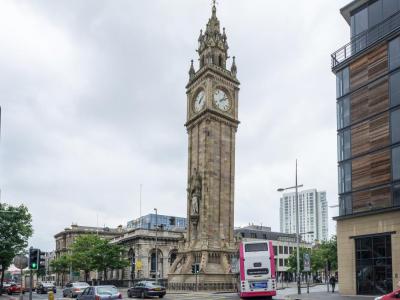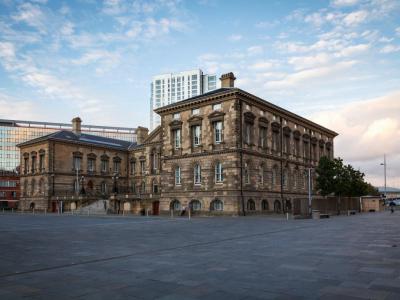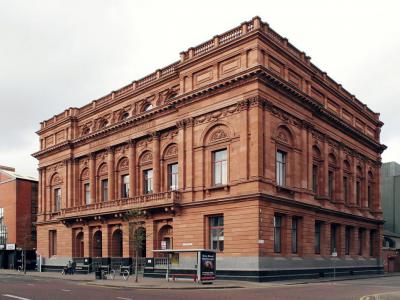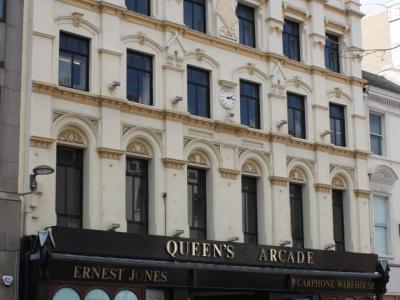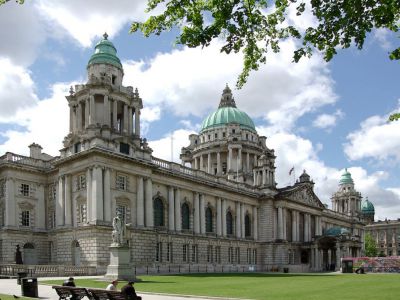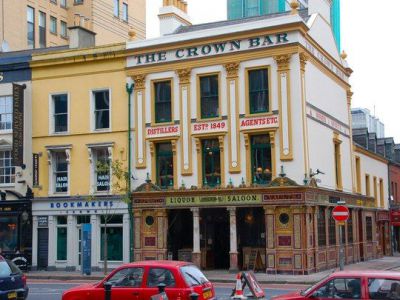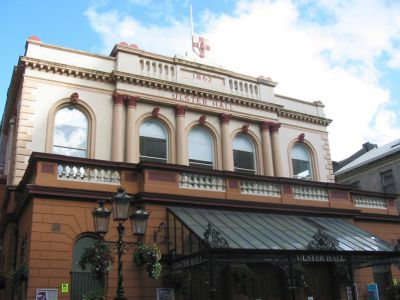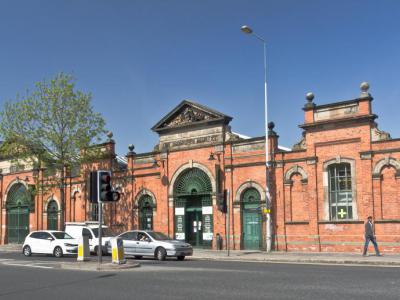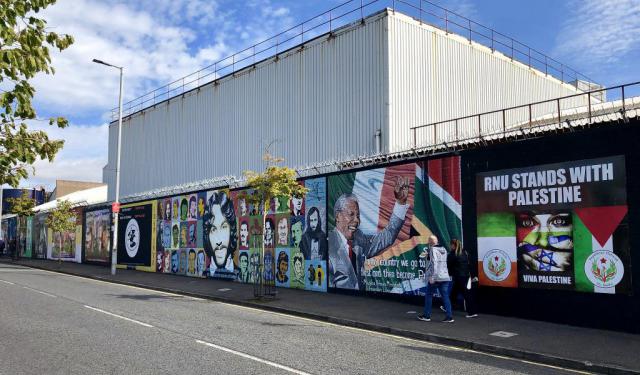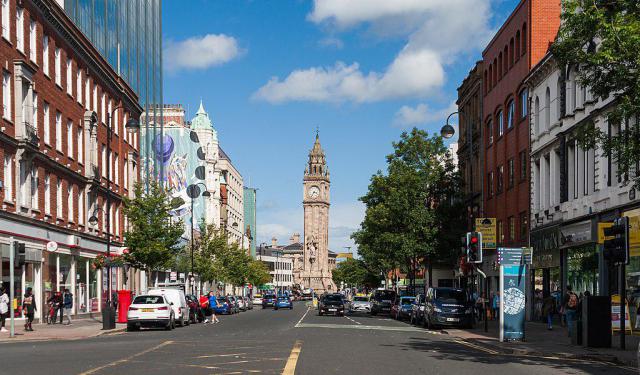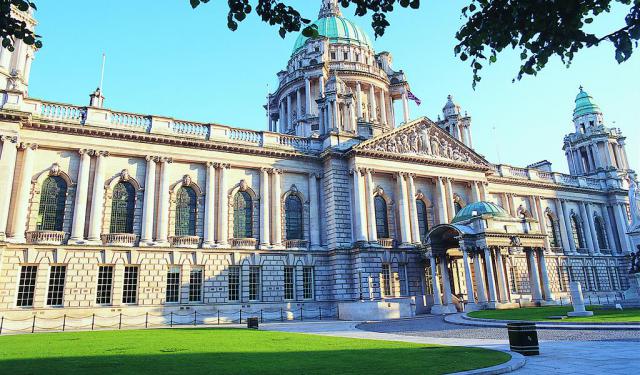
Belfast Victorian Architecture Jewels (Self Guided), Belfast
Described as “modestly scaled, undemonstrative, somewhat solid in aspect, and usually restrained (sometimes even austere) in its use of external decoration”, the urban landscape of Belfast has been influenced by the demands of shipbuilding and linen industry, much as transitioning between culture, arts, commerce, and education. Still, the architectural spectrum of the city is quite broad and features a variety of styles: from mock-Gothic to Neo-classical to Georgian to the cutting-edge modernist buildings, which makes it a worthy destination for architects and designers of all stripes.
Still, it is the city's vernacular British – Victorian and Edwardian – architecture that gets most of the notice, especially given that much of Georgian Belfast has disappeared, with the exception of a few prominent buildings that laid down ‘the basic characteristics of Ulster architecture’. Major developments in Belfast began when Queen Victoria was at the helm. Many of the city's Victorian era landmarks, including the Albert Memorial Clock and the Customs House, were designed by Sir Charles Lanyon.
Among other important local buildings survived from the 19th century there are:
Belfast City Hall – an oasis in the heart of the city; the impressive example of the late 19th-century Baroque Revival.
Grand Opera House – a beautiful creation by architect Frank Matcham, subtle yet artful, while quite humble in its presence.
Crown Liquor Saloon – a majestic, quintessentially Victorian saloon in the heart of Belfast, arguably its most famous watering hole; the façade is a tapestry of mosaics fit to make anyone stand and stare in awe.
Ulster Hall – originally designed for grand dances, but now used primarily as a concert and sporting venue.
If you want to explore the most beautiful Victorian architecture of Belfast in more detail, take this self-guided walk.
Still, it is the city's vernacular British – Victorian and Edwardian – architecture that gets most of the notice, especially given that much of Georgian Belfast has disappeared, with the exception of a few prominent buildings that laid down ‘the basic characteristics of Ulster architecture’. Major developments in Belfast began when Queen Victoria was at the helm. Many of the city's Victorian era landmarks, including the Albert Memorial Clock and the Customs House, were designed by Sir Charles Lanyon.
Among other important local buildings survived from the 19th century there are:
Belfast City Hall – an oasis in the heart of the city; the impressive example of the late 19th-century Baroque Revival.
Grand Opera House – a beautiful creation by architect Frank Matcham, subtle yet artful, while quite humble in its presence.
Crown Liquor Saloon – a majestic, quintessentially Victorian saloon in the heart of Belfast, arguably its most famous watering hole; the façade is a tapestry of mosaics fit to make anyone stand and stare in awe.
Ulster Hall – originally designed for grand dances, but now used primarily as a concert and sporting venue.
If you want to explore the most beautiful Victorian architecture of Belfast in more detail, take this self-guided walk.
How it works: Download the app "GPSmyCity: Walks in 1K+ Cities" from Apple App Store or Google Play Store to your mobile phone or tablet. The app turns your mobile device into a personal tour guide and its built-in GPS navigation functions guide you from one tour stop to next. The app works offline, so no data plan is needed when traveling abroad.
Belfast Victorian Architecture Jewels Map
Guide Name: Belfast Victorian Architecture Jewels
Guide Location: Ireland » Belfast (See other walking tours in Belfast)
Guide Type: Self-guided Walking Tour (Sightseeing)
# of Attractions: 10
Tour Duration: 2 Hour(s)
Travel Distance: 2.9 Km or 1.8 Miles
Author: DanaU
Sight(s) Featured in This Guide:
Guide Location: Ireland » Belfast (See other walking tours in Belfast)
Guide Type: Self-guided Walking Tour (Sightseeing)
# of Attractions: 10
Tour Duration: 2 Hour(s)
Travel Distance: 2.9 Km or 1.8 Miles
Author: DanaU
Sight(s) Featured in This Guide:
- Albert Memorial Clock
- Customs House
- Merchant's Hotel
- Belfast Central Library
- Queen's Arcade
- Belfast City Hall
- Grand Opera House
- Crown Liquor Saloon
- Ulster Hall
- St George's Market
1) Albert Memorial Clock
The Albert Memorial Clock is a tall clock tower located at Queen's Square. It was completed in 1869 and is one of the best known landmarks of Belfast.
In 1865, a competition for the design of a memorial to Queen Victoria's late Prince Consort, Prince Albert, was won by W. J. Barre, who had earlier designed Belfast's Ulster Hall. Initially Barre was not awarded his prize and the contract was secretly given to Lanyon, Lynn and Lanyon, who had come second. Following public outcry the contract was eventually awarded to Barre.
The sandstone memorial was constructed between 1865 and 1869 and stands 113 feet tall in a mix of French and Italian Gothic styles. The base of the tower features flying buttresses with heraldic lions. A statue of the Prince in the robes of a Knight of the Garter stands on the western side of the tower. Inside the tower there is a two tonne bell.
As a result of being built on wooden piles on marshy, reclaimed land around the River Farset, the top of the tower leans four feet off the perpendicular. Due to this movement, some ornamental work on the belfry was removed in 1924 along with a stone canopy over the statue of the Prince.
Being situated close to the docks, the tower was once infamous for being frequented by prostitutes plying their trade with visiting sailors. However, in recent years regeneration has turned the surrounding Queen's Square and Custom's House Square into attractive, modern public spaces with trees, fountains and sculptures.
In 1947, the popular British film "Odd Man Out" was filmed partly in Belfast, with the Albert Clock as a central location.
In 1865, a competition for the design of a memorial to Queen Victoria's late Prince Consort, Prince Albert, was won by W. J. Barre, who had earlier designed Belfast's Ulster Hall. Initially Barre was not awarded his prize and the contract was secretly given to Lanyon, Lynn and Lanyon, who had come second. Following public outcry the contract was eventually awarded to Barre.
The sandstone memorial was constructed between 1865 and 1869 and stands 113 feet tall in a mix of French and Italian Gothic styles. The base of the tower features flying buttresses with heraldic lions. A statue of the Prince in the robes of a Knight of the Garter stands on the western side of the tower. Inside the tower there is a two tonne bell.
As a result of being built on wooden piles on marshy, reclaimed land around the River Farset, the top of the tower leans four feet off the perpendicular. Due to this movement, some ornamental work on the belfry was removed in 1924 along with a stone canopy over the statue of the Prince.
Being situated close to the docks, the tower was once infamous for being frequented by prostitutes plying their trade with visiting sailors. However, in recent years regeneration has turned the surrounding Queen's Square and Custom's House Square into attractive, modern public spaces with trees, fountains and sculptures.
In 1947, the popular British film "Odd Man Out" was filmed partly in Belfast, with the Albert Clock as a central location.
Sight description based on Wikipedia.
2) Customs House
The Customs House is a historical building in Belfast. Completed in 1857, the building has been used by various governmental departments, including the Belfast Board of Works, the Inland Revenue, and an Income Tax Office.
Designed in 1847 by English architect Charles Lanyon and finished in 1857 at a cost of £30,000.
Throughout the years the building has undergone numerous alterations. In 1861 the building's forecourt was raised to allow greater basement space and a westward facing entrance was added. Again in 1872 the southern entrance (then used as a Post Office) was removed and replaced with another western entrance which was itself removed in 1886.
Further changes were again carried out in 1926 when the interior of the central and southern blocks were removed, a second floor was added above them and the building's original chimneys and eastern entrance's portico were demolished. A new staircase was installed in the northern block in 1940.
The building is closed to the public, but even from the outside, it's a magnificent and elegant building.
Designed in 1847 by English architect Charles Lanyon and finished in 1857 at a cost of £30,000.
Throughout the years the building has undergone numerous alterations. In 1861 the building's forecourt was raised to allow greater basement space and a westward facing entrance was added. Again in 1872 the southern entrance (then used as a Post Office) was removed and replaced with another western entrance which was itself removed in 1886.
Further changes were again carried out in 1926 when the interior of the central and southern blocks were removed, a second floor was added above them and the building's original chimneys and eastern entrance's portico were demolished. A new staircase was installed in the northern block in 1940.
The building is closed to the public, but even from the outside, it's a magnificent and elegant building.
3) Merchant's Hotel
Built of golden sandstone, the Merchant's Hotel building (former Ulster Bank ) is definitely worth seeing while in Belfast. It is a Victorian style construction with outstanding ornamentation that has received a great deal of admiration over the years. The building site was originally acquired in 1836, but the actual construction works began in 1857.
Bank directors Robert Grimshaw and James Heron traveled throughout the UK in order to find perfect examples of bank designs. Later, they held a competition for the best design and the winner was a talented Glaswegian named James Hamilton.
The exterior of the hotel is in decorated in Italian style, it sports three sculptures representing Commerce, Justice and Britannia on top of the fabulous facade. The hotel's main hall is decorated with fruit and foliage designs, and the four Corinthian columns complete the architectural complex of the interior.
Due to its magnificent design, the building of the Merchant's Hotel is known to be one of the most renowned and appreciated constructions in Belfast.
Bank directors Robert Grimshaw and James Heron traveled throughout the UK in order to find perfect examples of bank designs. Later, they held a competition for the best design and the winner was a talented Glaswegian named James Hamilton.
The exterior of the hotel is in decorated in Italian style, it sports three sculptures representing Commerce, Justice and Britannia on top of the fabulous facade. The hotel's main hall is decorated with fruit and foliage designs, and the four Corinthian columns complete the architectural complex of the interior.
Due to its magnificent design, the building of the Merchant's Hotel is known to be one of the most renowned and appreciated constructions in Belfast.
4) Belfast Central Library
Belfast Central Library is a public library in Royal Avenue, Belfast. Opened in 1888, it was one of the first major public library buildings in Ireland.
A competition for the design of the building was won by architect WH Lynn in 1883 and it was built by H & J Martin builders. Designed to reflect the ambitions of the growing city of Belfast, its architecture is a fine example of public-service building at the height of the Victorian age.
On a black granite base, the Dumfries red sandstone exterior with a slightly Italianate feel, houses a three-floor interior with a sweeping staircase, a pillared foyer, and a fine domed first-floor reading room. The top floor originally included a museum and art gallery.
The building is a notable part of the 19th century cityscape of modern Belfast. It has survived undamaged through the Belfast Blitz of World War II and the Troubles of the late 20th century.
A competition for the design of the building was won by architect WH Lynn in 1883 and it was built by H & J Martin builders. Designed to reflect the ambitions of the growing city of Belfast, its architecture is a fine example of public-service building at the height of the Victorian age.
On a black granite base, the Dumfries red sandstone exterior with a slightly Italianate feel, houses a three-floor interior with a sweeping staircase, a pillared foyer, and a fine domed first-floor reading room. The top floor originally included a museum and art gallery.
The building is a notable part of the 19th century cityscape of modern Belfast. It has survived undamaged through the Belfast Blitz of World War II and the Troubles of the late 20th century.
Sight description based on Wikipedia.
5) Queen's Arcade
Queen's Arcade is a Grade B1 listed shopping arcade in the centre of Belfast. An ornate Victorian 4-storey building, painted pastel yellow, featuring muted copper spires on the roof, a small white clockface in the centre of the 2nd floor, and ground floor shopping units framed in black, either side of the arched entrance to an arcade. On the third floor is an Art-Deco-influenced monogram with the letters "A.R.".
The arcade and the building above it were designed by James McKinnon in 1880, for developer George Fisher. During the 1980s and 1990s, the arcade was owned by Prudential Portfolio Managers Ltd. In 1987 they refurbished the building façades and installed canopies over the Donegall Place and Fountain Street entrances. They carried out further refurbishment works during 1994.
The building gained Grade B1 listed status in June 1993.
The arcade and the building above it were designed by James McKinnon in 1880, for developer George Fisher. During the 1980s and 1990s, the arcade was owned by Prudential Portfolio Managers Ltd. In 1987 they refurbished the building façades and installed canopies over the Donegall Place and Fountain Street entrances. They carried out further refurbishment works during 1994.
The building gained Grade B1 listed status in June 1993.
Sight description based on Wikipedia.
6) Belfast City Hall (must see)
Belfast City Hall is the civic building of the Belfast City Council. Located in Donegall Square, it faces north and effectively divides the commercial and business areas of the city centre.
The site now occupied by Belfast City Hall was once the home of the White Linen Hall, an important international Linen Exchange. The Street that runs from the back door of Belfast City Hall through the middle of Linen Quarter is Linen Hall Street. Plans for the City Hall began in 1888 when Belfast was awarded city status by Queen Victoria. This was in recognition of Belfast's rapid expansion and thriving linen, rope-making, shipbuildingand engineering industries. During this period Belfast briefly overtook Dublin as the most populous city on the island of Ireland. Construction began in 1898 under the supervision of architect Sir Alfred Brumwell Thomas and was completed in 1906.
The exterior is built mainly from Portland stone and is in the Baroque Revival style. It covers an area of one and a half acres and has an enclosed courtyard. Featuring towers at each of the four corners, with a lantern-crowned 173 ft (53 m) copper dome in the centre, the City Hall dominates the city centre skyline. As with other Victorian buildings in the city centre, the City Hall's copper-coated domes are a distinctive green. The pediment sculpture is by F. W. Pomeroy, assisted by local carver J. Edgar Winter, and features on the reverse side of the current series of £10, £20, £50 and £100 sterling banknotesissued by the Northern Bank.
The interior has a number of notable features, including The Porte-Cochère and Grand Entrance, The Grand Staircase, The Reception Room and The Great Hall. The latter was destroyed during the Belfast Blitz during WW2 and subsequently rebuilt. Various memorials are located in the building, including ones to Frederick Robert Chichester, Earl of Belfast, Sir Crawford and Lady McCullagh and the 36th (Ulster) Division.
The gardens surrounding the City Hall are a popular with office workers taking their lunch in the summer months, as well as tourists and teenagers gathering in their dozens to enjoy the green. Various statues stand on the grounds, including one of Queen Victoria by Sir Thomas Brock. There is also a granite column dedicated to the American Expeditionary Force. The grounds also house Northern Ireland's main war memorial, The Garden of Remembrance and Cenotaph, at which wreaths are laid on Remembrance Day.
The site now occupied by Belfast City Hall was once the home of the White Linen Hall, an important international Linen Exchange. The Street that runs from the back door of Belfast City Hall through the middle of Linen Quarter is Linen Hall Street. Plans for the City Hall began in 1888 when Belfast was awarded city status by Queen Victoria. This was in recognition of Belfast's rapid expansion and thriving linen, rope-making, shipbuildingand engineering industries. During this period Belfast briefly overtook Dublin as the most populous city on the island of Ireland. Construction began in 1898 under the supervision of architect Sir Alfred Brumwell Thomas and was completed in 1906.
The exterior is built mainly from Portland stone and is in the Baroque Revival style. It covers an area of one and a half acres and has an enclosed courtyard. Featuring towers at each of the four corners, with a lantern-crowned 173 ft (53 m) copper dome in the centre, the City Hall dominates the city centre skyline. As with other Victorian buildings in the city centre, the City Hall's copper-coated domes are a distinctive green. The pediment sculpture is by F. W. Pomeroy, assisted by local carver J. Edgar Winter, and features on the reverse side of the current series of £10, £20, £50 and £100 sterling banknotesissued by the Northern Bank.
The interior has a number of notable features, including The Porte-Cochère and Grand Entrance, The Grand Staircase, The Reception Room and The Great Hall. The latter was destroyed during the Belfast Blitz during WW2 and subsequently rebuilt. Various memorials are located in the building, including ones to Frederick Robert Chichester, Earl of Belfast, Sir Crawford and Lady McCullagh and the 36th (Ulster) Division.
The gardens surrounding the City Hall are a popular with office workers taking their lunch in the summer months, as well as tourists and teenagers gathering in their dozens to enjoy the green. Various statues stand on the grounds, including one of Queen Victoria by Sir Thomas Brock. There is also a granite column dedicated to the American Expeditionary Force. The grounds also house Northern Ireland's main war memorial, The Garden of Remembrance and Cenotaph, at which wreaths are laid on Remembrance Day.
Sight description based on Wikipedia.
7) Grand Opera House (must see)
The Grand Opera House is a historical theatre designed by the most prolific theatre architect of the period, Frank Matcham. It opened on 23 December 1895. According to The Theatres Trust the "magnificent auditorium is probably the best surviving example in the United Kingdom of the oriental style applied to theatre architecture".
It was renamed the Palace of Varieties in 1904, although it reverted to its original name in 1909. Variety programmes dominated in the 1920s and 1930s and the theatre saw performances by famous British performers such as Gracie Fields, Will Fyffe and Harry Lauder. It became a repertory theatre during World War II and at the celebrations to mark the end of the war, Eisenhower, Montgomery and Alanbrooke attended gala performances at the theatre.
The Grand Opera House was used as a cinema between 1949 and 1972, after which it was almost demolished, only to open again in 1980. The theatre was added to the list of national historical buildings in the 1970s and has been restored extensively since.
The building had been damaged by bombs on several occasions usually when the nearby Europa Hotel had been targeted. It was very badly damaged by bomb blasts in 1991 and 1993. The theatre continued to thrive, however, hosting musicals, plays, pantomimes and live music.
In 1995 the running of the theatre was taken over by the Grand Opera House Trust and an extensive renovation was undertaken in 2006. The theatre now also has a restaurant on the third floor called "The Hippodrome", on the ground floor a daytime bistro called "Luciano's" as well as space for corporate meetings and functions.
It was renamed the Palace of Varieties in 1904, although it reverted to its original name in 1909. Variety programmes dominated in the 1920s and 1930s and the theatre saw performances by famous British performers such as Gracie Fields, Will Fyffe and Harry Lauder. It became a repertory theatre during World War II and at the celebrations to mark the end of the war, Eisenhower, Montgomery and Alanbrooke attended gala performances at the theatre.
The Grand Opera House was used as a cinema between 1949 and 1972, after which it was almost demolished, only to open again in 1980. The theatre was added to the list of national historical buildings in the 1970s and has been restored extensively since.
The building had been damaged by bombs on several occasions usually when the nearby Europa Hotel had been targeted. It was very badly damaged by bomb blasts in 1991 and 1993. The theatre continued to thrive, however, hosting musicals, plays, pantomimes and live music.
In 1995 the running of the theatre was taken over by the Grand Opera House Trust and an extensive renovation was undertaken in 2006. The theatre now also has a restaurant on the third floor called "The Hippodrome", on the ground floor a daytime bistro called "Luciano's" as well as space for corporate meetings and functions.
Sight description based on Wikipedia.
8) Crown Liquor Saloon
The Crown Liquor Saloon is a public house located on Great Victoria Street. Refurbished to a high standard in 1885, it is an outstanding example of a Victorian gin palace, and is one of Northern Ireland's best-known pubs.
Originally opened by Felix O'Hanlon and known as The Railway Tavern, the pub was then bought by Michael Flanagan. Flanagan's son Patrick renamed and renovated the pub in 1885. The Crown owes its elaborate tiling, stained glass and woodwork to the Italian craftsmen whom Flanagan persuaded to work on the pub after hours. These craftsmen were brought to Ireland to work on the many new churches being built in Belfast at the time. It was this high standard of work that gave the Crown the reputation of being one of the finest Victorian Gin Palaces of its time.
In 1978 the National Trust purchased the property and three years later completed the renovation to restore the bar to its original Victorian state. Further restoration by the National Trust was done in 2007. This work is the subject of a BBC Northern Ireland documentary entitled Jewel in the Crown, first screened early 2008.
A recognizable landmark of Belfast, the pub has featured as a location in numerous film and television productions, such as David Caffrey's Divorcing Jack in 1998 and as far back as Carol Reed's 1947 film Odd Man Out. The Crown has been given a Grade A Listed Building status by the Environment and Heritage Service.
The building exterior is decorated in polychromatic tiles. This includes a mosaic of a Crown on the floor of the entrance. The interior is also decorated with complex mosaics of tiles. The red granite topped bar is of an altar style, with a heated footrest underneath and is lit by gas lamps on the highly decorative carved ceilings.
The Crown has ten booths, or snugs. Built to accommodate the pub's more reserved customers during the austere Victorian period, the snugs feature the original gun metal plates for striking matches and an antique bell system for alerting staff. Extra privacy was then afforded by the pub's etched and stained glass windows which feature painted shells, fairies, pineapples, fleurs-de-lis and clowns.
Originally opened by Felix O'Hanlon and known as The Railway Tavern, the pub was then bought by Michael Flanagan. Flanagan's son Patrick renamed and renovated the pub in 1885. The Crown owes its elaborate tiling, stained glass and woodwork to the Italian craftsmen whom Flanagan persuaded to work on the pub after hours. These craftsmen were brought to Ireland to work on the many new churches being built in Belfast at the time. It was this high standard of work that gave the Crown the reputation of being one of the finest Victorian Gin Palaces of its time.
In 1978 the National Trust purchased the property and three years later completed the renovation to restore the bar to its original Victorian state. Further restoration by the National Trust was done in 2007. This work is the subject of a BBC Northern Ireland documentary entitled Jewel in the Crown, first screened early 2008.
A recognizable landmark of Belfast, the pub has featured as a location in numerous film and television productions, such as David Caffrey's Divorcing Jack in 1998 and as far back as Carol Reed's 1947 film Odd Man Out. The Crown has been given a Grade A Listed Building status by the Environment and Heritage Service.
The building exterior is decorated in polychromatic tiles. This includes a mosaic of a Crown on the floor of the entrance. The interior is also decorated with complex mosaics of tiles. The red granite topped bar is of an altar style, with a heated footrest underneath and is lit by gas lamps on the highly decorative carved ceilings.
The Crown has ten booths, or snugs. Built to accommodate the pub's more reserved customers during the austere Victorian period, the snugs feature the original gun metal plates for striking matches and an antique bell system for alerting staff. Extra privacy was then afforded by the pub's etched and stained glass windows which feature painted shells, fairies, pineapples, fleurs-de-lis and clowns.
Sight description based on Wikipedia.
9) Ulster Hall
The Ulster Hall is a concert hall and historical building in Belfast. Situated on Bedford Street in Belfast city center, the hall hosts concerts, classical recitals, craft fairs and political party conferences. Despite the opening of larger concert halls in the city, such as the Waterfront Hall and the Odyssey, the Ulster Hall has remained a very popular venue, and is considered to evoke much more atmosphere than the newer venues.
Built in 1859 and opened in 1862, the hall's purpose was to provide the expanding city of Belfast with a multi-purpose venue of sufficient size. The Ulster Hall features one of the oldest examples of a functioning classic English pipe organ. The Mulholland Grand Organ is named in honor of former Lord Mayor of Belfast, Andrew Mulholland, who donated it to the hall in the 1860s. It was built by William Hill & Son and donated after the hall was officially opened. In the late 1970s, the organ was extensively restored to Hill's own original design. Mullholland's great-great-grandson, Henry Mulholland, 4th Baron Dunleath, oversaw the restoration.
In 1902, Belfast City Council commissioned the local artist Joseph W. Carey to produce thirteen scenes from Belfast history on canvas, to be mounted within the Ulster Hall. The scenes depict the city and the surrounding area, incorporating historical and mythological influences.
In 2007, a major refurbishment plan was done to restore the venue back to its original condition, while also modernizing the building's facilities and providing better disabled access.
Built in 1859 and opened in 1862, the hall's purpose was to provide the expanding city of Belfast with a multi-purpose venue of sufficient size. The Ulster Hall features one of the oldest examples of a functioning classic English pipe organ. The Mulholland Grand Organ is named in honor of former Lord Mayor of Belfast, Andrew Mulholland, who donated it to the hall in the 1860s. It was built by William Hill & Son and donated after the hall was officially opened. In the late 1970s, the organ was extensively restored to Hill's own original design. Mullholland's great-great-grandson, Henry Mulholland, 4th Baron Dunleath, oversaw the restoration.
In 1902, Belfast City Council commissioned the local artist Joseph W. Carey to produce thirteen scenes from Belfast history on canvas, to be mounted within the Ulster Hall. The scenes depict the city and the surrounding area, incorporating historical and mythological influences.
In 2007, a major refurbishment plan was done to restore the venue back to its original condition, while also modernizing the building's facilities and providing better disabled access.
Sight description based on Wikipedia.
10) St George's Market (must see)
St George's Market is the last surviving Victorian covered market in Belfast. It was built in three phases between 1890 and 1896. Before 1890, St George's Market was an open market and most likely contained a slaughterhouse and a meat market.
The original (pre 1890) market was smaller than the new structure. It was built in red brick with sandstone dressing. Externally it features Roman styled arches with Latin and Irish inscriptions - the City’s Latin motto "what shall we give in return for so much?" and the Irish phrase "Red Hand of Ireland".
The main entrance arch displays the Belfast Coat of Arms. This newly covered market opened to the public on 20 June 1890. By the 1980s, St George’s Market had developed into a general market and it became the last of Belfast’s thriving Victorian markets.
Today St George’s Market is primarily used as a food market, however a number of other events are held at the site. These range from food festivals, art initiatives, exhibitions, charity launches, fashion shoots and live music events. The market also regularly holds music concerts. Acts including Duffy, Newton Faulkner, Deep Purple, Biffy Clyro and Mark Ronson have played the venue.
The original (pre 1890) market was smaller than the new structure. It was built in red brick with sandstone dressing. Externally it features Roman styled arches with Latin and Irish inscriptions - the City’s Latin motto "what shall we give in return for so much?" and the Irish phrase "Red Hand of Ireland".
The main entrance arch displays the Belfast Coat of Arms. This newly covered market opened to the public on 20 June 1890. By the 1980s, St George’s Market had developed into a general market and it became the last of Belfast’s thriving Victorian markets.
Today St George’s Market is primarily used as a food market, however a number of other events are held at the site. These range from food festivals, art initiatives, exhibitions, charity launches, fashion shoots and live music events. The market also regularly holds music concerts. Acts including Duffy, Newton Faulkner, Deep Purple, Biffy Clyro and Mark Ronson have played the venue.
Walking Tours in Belfast, Ireland
Create Your Own Walk in Belfast
Creating your own self-guided walk in Belfast is easy and fun. Choose the city attractions that you want to see and a walk route map will be created just for you. You can even set your hotel as the start point of the walk.
The Troubles and Peace Process Landmarks
Decades past the official end of The Troubles in Belfast, the price of peace in Northern Ireland remains high. One of the means with which to secure it, back in 1969, was erecting a wall to physically separate the capital's warring Protestant and Catholic communities. Known since as the Peace Wall, the structure has become a popular tourist attraction for the multiple murals painted thereon... view more
Tour Duration: 1 Hour(s)
Travel Distance: 2.1 Km or 1.3 Miles
Tour Duration: 1 Hour(s)
Travel Distance: 2.1 Km or 1.3 Miles
Belfast Introduction Walking Tour
For over a century, the political situation of Belfast, the capital of Northern Ireland, has been the source of strife, first between the Crown-loyal Protestants and Irish Catholics, and more recently between the United Kingdom and the European Union.
Sitting on the banks of the River Lagan where it meets the Irish Sea, the city owes its name to this coastal condition, with "Belfast"... view more
Tour Duration: 2 Hour(s)
Travel Distance: 3.8 Km or 2.4 Miles
Sitting on the banks of the River Lagan where it meets the Irish Sea, the city owes its name to this coastal condition, with "Belfast"... view more
Tour Duration: 2 Hour(s)
Travel Distance: 3.8 Km or 2.4 Miles
The Most Popular Cities
/ view all
